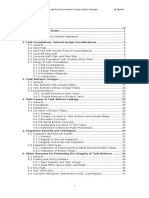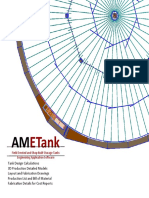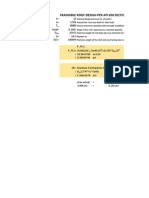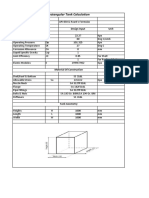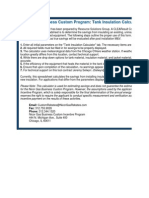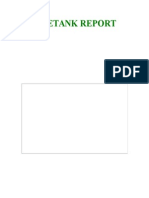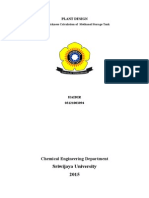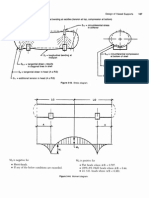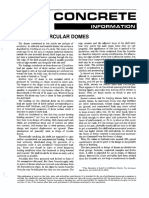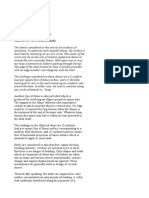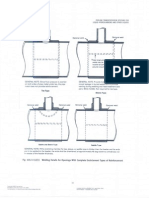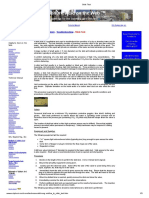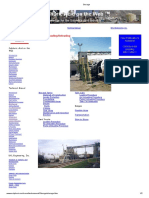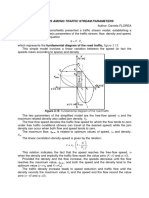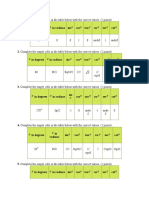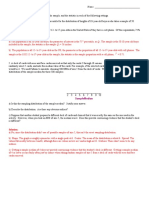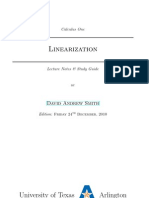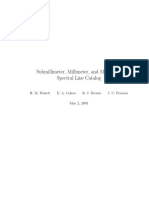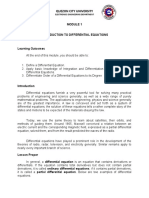Anchor Chair
Anchor Chair
Uploaded by
rsubramaniCopyright:
Available Formats
Anchor Chair
Anchor Chair
Uploaded by
rsubramaniOriginal Description:
Copyright
Available Formats
Share this document
Did you find this document useful?
Is this content inappropriate?
Copyright:
Available Formats
Anchor Chair
Anchor Chair
Uploaded by
rsubramaniCopyright:
Available Formats
------------- - .
PAGE 63
, SAUDI TOYO - K.S.A
+955-4-3955188
68/29/1998 13:60
steel t V)<1't\ee
vl
na
2 'Y!l
- ,
Part VII
Anchor Bolt Chairs
.,
When anchorboltsare required atsupportsfora r '" least radius ofgyration, in.
shell, chairsare necessary10 distribute theload to
theshell. Small tubularcolumns (less than4 ft in
R = nominal shell radius. in_. eitherto inside or
diameter) maybean exception if thebase plate is
centerlineofplate (r.ldius normal tocone
adequateto take thebending. Otherwise, chairs
atbottomendfor conical shells)
are alwaysneeded tominimizesecondary bending
S '" stressatpoint,ksi
in theshell.
Forflat-bottomed tanks,chooseaboltcircle to
r = shell orcolumn thickness. in.
justbarelyclearthe bottomwithout notching it.
Forotherstructures,follow theminimum clearances
w = weld size (leg dimension), in_
shown in Fig. lOa.
W ::: total load onweld, kipsper lin. in. ofweld
Notation
WH = horizontal load. kips perlin in. of weld
a = top-platewidth, in.. alongshell
Wv = vertical load,kipsperlin in. ofweld
b = topplate length, in. in radial direction
o = coneangle. degrees, measured from axisof
c = topplate thickness, in. cone
Z == reductionfor factor
d '" anchor-boltdiameter. in.
TopPlate
e := anchorbolt eccentricity. in.
Critical stressin thetopplateoccursbetween the
holeand the free edge ofthe plate. Forconvenience
emin== 0.8860'+0.572,based onaheavy hex nut
we can considerthis portionofthe topplateas a
clearing shell by 1/2 in.SeeTable 5.
beamwith partiallyfixed ends,with a portionof
f = distance. in., from outsideoftop plate to the total anchorboltloaddistributed along part
edgeofhole ofthe span.See Fig. 11.
f min=d /2 +1/8 s = --; (O.375g - O.22d)
(44)
fe
9 = distance. in.. betweenvertical plates (pre
ferred 9 rz:: d +1)
or
h = chairheight. in.
c '" [L.(0.3759_ O.22d)] 1/2 (45)
Sf
i
=vertical-plate thickness, in.
k = vertical-platewidth,in. (average width for Topplatemayproject radially beyondvertical
tapered plates) plates as in Fig. 100', butno more than 1/2".
L '" column length, in.
Chair Height
m =bottomorbase platethickness, in.
Chairmust behigh enoughtodistribute anchor
bolt load to shell orcolumnwithoutoverstressing_
P ::a design load, kips, ormaximumallowable
it. If theanchorboltwere in linewith theshell
anchor-boltload or 1.5timesactual bolt
theproblemwould besimple- thedifficulty lies
load,whichever is less
in thebending caused byeccentricityof the
47
...-._-----.---
- ._-
PAGE 64
A SAUDI TOYO - K. S. A
+955-4-3955188
.f
(bl Vertical Column
or Skirt
(aJ Typical.Plan &
Outside Views
(c) Flat Bottom Tank (dl Conical Skirt
Fig. 10. Anchor-bolt Chairs_
Fig. 11. Assumed top-plate beam.
anchor bolt with respect to the shell. Except for
the case where a continuous ring is used at the top
of chairs, maximum stress occurs in the vertical
direction and is a combination of bending plus
direct stress. Formulas which follow are approxima-
tions, based on the work of Bijlaard.
s - Pe [1.32 Z .031 ] (461
-7 1 43ah1 +-=-
-'-R-l- + (411h
2
l:
J33
y Rl
48
Table 4. Top-Plate Dimensions
B...d on ."ellor.bolt .tr.nes up 10 12 ... lor l-l/2-;".-<li.
boilS ."d 15 Ie.i for boH, in. in Or 1"0.':
I- d/2" 118.
e cd I, <: Irom emi" c 01l66d. 0.572. a"d Ell. (45)
.a - 9 + 2. All dimrension'l ;n i"choes.
AWY'i.A &
NFPA eM'--
f---
, Ig-,Hl -min P emln f' c",in d
l',n 11IR 1:2 1/2 41/ 1.87 19."
0_734 2:1.9 0.815
1 1 !13/4 .. 2.09 32.7 0,919 AO.5 1.023
'2 1 lIBI :) 5 12.30 43.1 1.025 534 1"'"
1/" 1 1/413 1/4 51/4 ? 0;7 r: 11141; '7n,
I, "4
-'min (0" wrcical Jkiru onty on nUl
"Ctlle.ogo Bndgc & Iron Compeny
Where: Z =_1...;.0'-- -= _
. '77 am (!:'l) 2+ 1.0
(47
V1<T t
Maximum recommended stress is 25 ksi, This
a local stress occurring just above the top of the
chair. Since il diminishes rapidly away from the cht
a higher than normal stress ;s justified but an in-
crease for temporary loads. such as earthquake 01
wind is not recommended. The following general
guidelines are recommended:
Minimum chair height h =6': except use h =1
when base plate or bottom plate is 3/8" or thinr
and where earthquake or winds over 100 mph
must be considered.
Maximum recommended chair heighl h =33.
If chair height c'alculated is excessive, reduce
eccentricity e. if possible, or use more anchor bolt'
of 3 smaller diameter. Another solution is to use a
continuous ring at top of chairs,
If continuous ring is used, check for maximum
stress in circumferential direction, considering the
I
ring as though it were loaded with equally spaced
concentrated loads equal to Pelh. Portion of shell r
within 16t either side of the attachment may be
I
counted as part of the ring.
!
Fig. 12. Chair With Continuous Ring at Top
I
I
i
PAGE 05
.3:00 +966-a-3955188
A SAUDI TOYO - K.S.A
Notethatthe baseplate or boltom is also sub-
jectedtothissame horizontal force, except inward
insteadofoutward.This is trueeven ifa continuous
ring is notusedaround the topof the cha irs - but
it should never causeanyveryhigh stressesin the
base,sowedo notnormallycheck it. However, it
is a good thing to keep in mind in caseyou have a
very light b<lse ring.
VerticalSidePlates
Be sure top platedoes notoverhangside plate (&s
.1 in Fig. 10dJ by morethan 1/2"radially.
Vertical-platethicknessshould beatleast
imin == 1/2"orO.04(h - c). whichever is greater.
Anotherrequirement is ik ;;;. P125, wherek is
the average width if plate is tapered.
These limitsassure a maximum Llr of86.6and
a maximumaverage stress in thesideplatesof12.5
ksi, even assuming no load was transmittedinto the
shell through the welds.
AssemblyofChair
Forfield erectedstructures,shipeitherthetop
plateor theentirechair loose for installation
afterthestructure is sittingover the anchor bolts.
We wantto avoid making thefield men thread the
anchorboltthrough twosetsofholes whenset-
ting thestructurein place.
Wherebase plate is welded toskirtorcolumn
in shop,attachsideplates in the shopandship
top plate loose for field assembly. See Fig. 13.
I)
l.V
4
IV
Fig. 13.TypicalWelding,
BasePlateShopAttached
Fig. 14.TypicalWelding
Baseor Bottom Field Attached
49
?:". . :00=,...,.....,.."....----,----------.----
Where base or bottom plate is not welded to
shell in theshop,as for flatbottom tanksand
waterspheres, shopattachside plates to topplates
and thenshiptheassembly for field installation,
When you dothis, weld bothsidesattopofside
platessoshrinkagewill notpull side plateoutof
square. See Fig. 14.
Welds betweenchairand Shell mustbestrong
enough to transmitload toshell. 1/4" filletwelds
as shown in Figs. 13 and 14 are nearly always
adequate,butyou should checkthem if you have
a largeanchorboltwitha lowlug
Assume a stressdistribution asshown in Fig. 15
as thoughtherewerea hinge at bottomofchair.
Forthe purposeoffiguring weld size, thebaseor ..
bottom plateis assumed to take horizontalthrust
only, not moment.
Notethat loadsarein termsofkips per inch of
weld length, notin terms ofkipspersquareinch
suess. Criticalstressoccursacrossthe top ofthe
chair. Thetotal load perinch on theweld is the
resultantofthevertical and horizontal loads.
Formulas mayalso beused for cones. although ..
this underrates theverticaIweldssome_ ..
::r
p
W.., : 0 + 2h
Pe
V! H .. -a-h-.'-O-'-.-66-:-:7=:'h-:"'
w
,,;,C'
.; .'./
Fig. 15. Loads onWelds
Foranallowablestressof 13.6 ksi ona fillet
weld. theallowllble load per lin in. is 13.6X
0.707 =9.6 kipsperin. ofweld size. For weld
size w. in., the allowable load therefore is
9.6w > W
(sii
I
I
You might also like
- Marine Boilers by G.T.H Flanagan 3rd EditionDocument123 pagesMarine Boilers by G.T.H Flanagan 3rd EditionRicky Chua100% (9)
- WRC Bulletin 537 - Rectangular Attachment (Excel)Document21 pagesWRC Bulletin 537 - Rectangular Attachment (Excel)Rey FiedacanNo ratings yet
- API 620 DesignDocument27 pagesAPI 620 Designrsubramani100% (2)
- EEMUA Publication 183 - Guide For The Prevention of Tank Bottom Leakage © EemuaDocument4 pagesEEMUA Publication 183 - Guide For The Prevention of Tank Bottom Leakage © EemuaCRISTIAN SILVIU IANUCNo ratings yet
- Ringwall ExampleDocument1 pageRingwall ExampleJorge Lovera HurtadoNo ratings yet
- Bottom Failure - Annex K - en 14015 - Rev 3Document3 pagesBottom Failure - Annex K - en 14015 - Rev 3KP SahuNo ratings yet
- B.4.4 - STD Spec For Steel StacksDocument6 pagesB.4.4 - STD Spec For Steel StacksHernan RodriguezNo ratings yet
- Caesar Wrc107and297Document3 pagesCaesar Wrc107and297spiritizNo ratings yet
- API 650 Water Storage TankDocument60 pagesAPI 650 Water Storage TankHgagselim Selim100% (2)
- PVP2016 Final ProgramDocument76 pagesPVP2016 Final Programthaivinhtuy100% (1)
- Silletas - Tanques API Metodo AISCDocument5 pagesSilletas - Tanques API Metodo AISCHEINER_PNo ratings yet
- Fatigue Failures of Welded Conveyor DrumsDocument11 pagesFatigue Failures of Welded Conveyor DrumsWashington MoraisNo ratings yet
- Bspd5500 Nozzle CalculationDocument24 pagesBspd5500 Nozzle CalculationrsubramaniNo ratings yet
- API 620 DesignDocument19 pagesAPI 620 DesignrsubramaniNo ratings yet
- API 650 Water Storage TankDocument84 pagesAPI 650 Water Storage TankZaki AnwerNo ratings yet
- Structurally Supported Conical RoofDocument10 pagesStructurally Supported Conical Rooframu karriNo ratings yet
- Required Dim. & Qty. of Plates For 5000 m3 HFO Storage Tank PDFDocument1 pageRequired Dim. & Qty. of Plates For 5000 m3 HFO Storage Tank PDFJahid Jahidul Islam KhanNo ratings yet
- Bolted Water Tank SpecsDocument7 pagesBolted Water Tank SpecsMakulay Ang BuhayNo ratings yet
- Bolted Tank Specifications Final 11-5-15Document6 pagesBolted Tank Specifications Final 11-5-15Rodrigo ZapataNo ratings yet
- Skirt Support Analysis TransportDocument5 pagesSkirt Support Analysis TransportHunnymijie NorNo ratings yet
- Fdocuments - in API 650 Storage TanksDocument15 pagesFdocuments - in API 650 Storage TanksRAHUL THAKORNo ratings yet
- AMETank Product BrochureDocument6 pagesAMETank Product BrochureSYedZYnAleNo ratings yet
- PV Elite (Construccion de Recipiente) MDMTDocument8 pagesPV Elite (Construccion de Recipiente) MDMTAlejandro CanoNo ratings yet
- Pip STF-05520Document7 pagesPip STF-05520mahmoodhassan79563100% (2)
- Single Bolt Embedment Design - Aci 349Document1 pageSingle Bolt Embedment Design - Aci 349Akhtar BahramNo ratings yet
- Api 650 Uplift ForcesDocument2 pagesApi 650 Uplift ForcesGerman DiBaccoNo ratings yet
- AMETank 14 Release Notes 14.3 2021 03 12Document3 pagesAMETank 14 Release Notes 14.3 2021 03 12Pierre DibNo ratings yet
- Frangible RoofDocument8 pagesFrangible RoofamevaluacionesNo ratings yet
- B04-F03 REV 1 March 2018 Pipe RailignsDocument4 pagesB04-F03 REV 1 March 2018 Pipe Railigns15150515715No ratings yet
- Kuan 2009 AppendixDocument14 pagesKuan 2009 AppendixMohammed EljammalNo ratings yet
- 134004-SEP-MEC-DAT-0004 Rev.B2 PDFDocument11 pages134004-SEP-MEC-DAT-0004 Rev.B2 PDFDhakshina KNo ratings yet
- 11.3 Chimney System DesignDocument3 pages11.3 Chimney System DesignkolkNo ratings yet
- InsulationDocument13 pagesInsulationBaDa Lee100% (1)
- EN13445 TWR OutDocument124 pagesEN13445 TWR OutCosimo100% (1)
- AMETank Calculations Notes 10.10 2017 11 01Document9 pagesAMETank Calculations Notes 10.10 2017 11 01ராபர்ட் ஆன்றோ ரெனிNo ratings yet
- PSV Calculation PSV-201Document1 pagePSV Calculation PSV-201ASHWINI BHOSALENo ratings yet
- Braced Legs ClaculationsDocument2 pagesBraced Legs Claculationssumit_waghmareNo ratings yet
- Min. Nozzles Spacing API-650Document1 pageMin. Nozzles Spacing API-650jojo_323No ratings yet
- Anchors For Anchoring To ConcreteDocument4 pagesAnchors For Anchoring To ConcreteahsanmohNo ratings yet
- API 650 ENOC Spec. - Rev.3 - Dated 22-09-2005Document21 pagesAPI 650 ENOC Spec. - Rev.3 - Dated 22-09-2005Elias Elias100% (1)
- 3191-CS-01 Rev A-009-011Document3 pages3191-CS-01 Rev A-009-011Syed Zain AliNo ratings yet
- Rectangular Tank CalculationDocument6 pagesRectangular Tank Calculationprince kumarNo ratings yet
- TK-ALCOZAP-2020-01-06-Rev. DDocument65 pagesTK-ALCOZAP-2020-01-06-Rev. DDaniel Gómez100% (1)
- API 650 Tank Design CalculationsDocument8 pagesAPI 650 Tank Design CalculationsMohammed EljammalNo ratings yet
- Tank Insulation CalculatorDocument4 pagesTank Insulation CalculatorJoshua JohnsonNo ratings yet
- CONE Plate ReqdDocument2 pagesCONE Plate ReqdneelNo ratings yet
- API 650 OutputDocument88 pagesAPI 650 Outputaby_abraham50050% (1)
- Nozzle Calcs Rev ADocument6 pagesNozzle Calcs Rev AbolivarNo ratings yet
- Dome Roof TableDocument1 pageDome Roof Tablejojo_323No ratings yet
- Api - 650 - 2007 - 40Document1 pageApi - 650 - 2007 - 40Raul GonzaloNo ratings yet
- Preva: Pressure Vessels and Heat ExchangersDocument6 pagesPreva: Pressure Vessels and Heat ExchangersTrishul Nath PallayNo ratings yet
- Calculate The Wall Thickness of Methanol Storage TankDocument4 pagesCalculate The Wall Thickness of Methanol Storage TankhaidirNo ratings yet
- Floating Roofs Single DeckDocument41 pagesFloating Roofs Single DeckjwochNo ratings yet
- Copiar de Nozzle - Design - ToolDocument2 pagesCopiar de Nozzle - Design - ToollavascudoNo ratings yet
- AISI - Anchor Chair DesignDocument3 pagesAISI - Anchor Chair DesignJoséSebastián86% (7)
- Pressure Vessel SupportDocument36 pagesPressure Vessel SupportAndreea Luca83% (6)
- Design of Circular DomesDocument8 pagesDesign of Circular Domesrshyams100% (1)
- Portland Cement AssociationDocument23 pagesPortland Cement AssociationDhm KrinisNo ratings yet
- Reference #08 - JNL-SO73-1 Bleacher SeatsDocument7 pagesReference #08 - JNL-SO73-1 Bleacher SeatsAriel Gonzalez100% (1)
- PipelineDocument3 pagesPipelineKrystle FlowersNo ratings yet
- Structural Analysis and Design Lectures PDFDocument354 pagesStructural Analysis and Design Lectures PDFgongmaozheNo ratings yet
- How To Design With Precision BallscrewsDocument10 pagesHow To Design With Precision BallscrewsRichard CapewellNo ratings yet
- Idesa Parque Científico Tecnológico 33203 Gijón Ref Nº: 2/942-100A C/Profesor Potter Nº 105Document23 pagesIdesa Parque Científico Tecnológico 33203 Gijón Ref Nº: 2/942-100A C/Profesor Potter Nº 105rsubramaniNo ratings yet
- Strong Acid System Troubleshooting: - Stick TestDocument3 pagesStrong Acid System Troubleshooting: - Stick TestrsubramaniNo ratings yet
- Storage/Loading/Unloading: Knowledge For The Sulphuric Acid Industry Sulphuric Acid On The WebDocument2 pagesStorage/Loading/Unloading: Knowledge For The Sulphuric Acid Industry Sulphuric Acid On The WebrsubramaniNo ratings yet
- Cone DevelopmentDocument1 pageCone DevelopmentrsubramaniNo ratings yet
- Saddle Calc PD5500Document4 pagesSaddle Calc PD5500rsubramaniNo ratings yet
- Weld Shear Stress Check For FAVID Clips Welded On CladDocument3 pagesWeld Shear Stress Check For FAVID Clips Welded On Cladrsubramani100% (1)
- Top Pipe MomentDocument2 pagesTop Pipe Momentrsubramani100% (1)
- External Pressure DesignDocument395 pagesExternal Pressure DesignrsubramaniNo ratings yet
- Bus RouteDocument5 pagesBus RoutersubramaniNo ratings yet
- Water Resources Engineering Reg & ContentsDocument56 pagesWater Resources Engineering Reg & ContentsHoward GhanaNo ratings yet
- Lec2 Part1Document35 pagesLec2 Part1Akram TaNo ratings yet
- Python ProgrammingDocument59 pagesPython Programmingmansooralikhan ANo ratings yet
- For Modern MathematicsDocument2 pagesFor Modern MathematicsLim CheeNo ratings yet
- 3 3 Traffic Parameters RelationshipDocument4 pages3 3 Traffic Parameters RelationshipCosmyn CojocaruNo ratings yet
- Beauty and The Labor Market (Hamermash, AER 1994)Document22 pagesBeauty and The Labor Market (Hamermash, AER 1994)Adeel TariqNo ratings yet
- 1.4.3 Practice - Intro To TrigDocument3 pages1.4.3 Practice - Intro To TrigCorrelanderNo ratings yet
- Unit 2 - 1Document13 pagesUnit 2 - 1jidey30017No ratings yet
- When The Going Gets Tough: Schools in Challenging Circumstances and The Effectiveness of Principals' Leadership StylesDocument17 pagesWhen The Going Gets Tough: Schools in Challenging Circumstances and The Effectiveness of Principals' Leadership StyleswardahNo ratings yet
- Cube in CubeDocument1 pageCube in CubeRanDy SNo ratings yet
- Teu13 PPT ch02Document102 pagesTeu13 PPT ch02HasanNo ratings yet
- Circle in Coordinate Plane Lesson2Document23 pagesCircle in Coordinate Plane Lesson2Norielyn DamasoNo ratings yet
- Approximate MatchingDocument16 pagesApproximate Matchingskgcp864355No ratings yet
- DT Q A DX DT Q KA DX: OverallDocument193 pagesDT Q A DX DT Q KA DX: OverallHARI B SNo ratings yet
- Special Square MatricesDocument1 pageSpecial Square MatricesRicardo Emilio AranaNo ratings yet
- Pumping Lemma WriteupDocument3 pagesPumping Lemma WriteuprimiNo ratings yet
- Chapter 7 Worksheet With AnswersDocument3 pagesChapter 7 Worksheet With AnswersnathanNo ratings yet
- Patel 4UDocument375 pagesPatel 4UJoe71% (7)
- B SCDocument56 pagesB SCRythemBansalNo ratings yet
- Vector LP DONEDocument3 pagesVector LP DONEDave Cercado BugadorNo ratings yet
- CSI521 Discrete Math-Homework3Document2 pagesCSI521 Discrete Math-Homework3Raghavendra Vamsi teja ChNo ratings yet
- Wa0032.Document4 pagesWa0032.abnightmare158No ratings yet
- Measures of DispersionDocument11 pagesMeasures of DispersionKristen Imie Dungog LacapagNo ratings yet
- Beginners Horoscope Maker and ReaderDocument182 pagesBeginners Horoscope Maker and Readerfriendz7774634100% (4)
- Linear IzationDocument8 pagesLinear IzationGiora RozmarinNo ratings yet
- SM GM Akcd L009Document3 pagesSM GM Akcd L009kimflewNo ratings yet
- Submillimeter, Millimeter, and Microwave Spectral Line CatalogDocument359 pagesSubmillimeter, Millimeter, and Microwave Spectral Line CatalogkomalrathorNo ratings yet
- Module - 1 Introduction To Differential EquationsDocument5 pagesModule - 1 Introduction To Differential EquationsJade B. BermasNo ratings yet
- Technical Catalogue B Iec STD en Rev0 2020Document204 pagesTechnical Catalogue B Iec STD en Rev0 2020samanta prasantaNo ratings yet
- Physics Project ReportDocument12 pagesPhysics Project ReportSanu Soumya80% (5)



